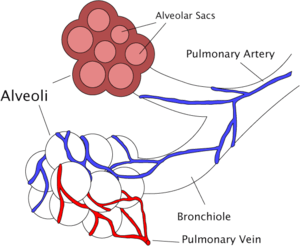A terminal bronchiole is a bronchiole at the end of the conducting zone, which covers the first division through the sixteenth division of the respiratory tract. Alveoli only become present when the conducting zone changes to the respiratory zone, from the sixteenth through the twenty-third division of the tract.
The terminal bronchiole is the most distal segment of the conducting zone. It branches off the lesser bronchioles. Each of the terminal bronchioles divides to form respiratory bronchioles which contain a small number of alveoli. Terminal bronchioles are lined with simple cuboidal epithelium containing Clara cells. Terminal bronchioles contain a limited number of ciliated cells and no goblet cells. Clara cells are non-ciliated, rounded protein secreting cells. Their secretions are a nonsticky, proteinaceous compound to maintain the airway in the smallest bronchioles. The secretion, called surfactant, reduces surface tension, allowing for bronchioles to expand during inspiration and keeping the bronchioles from collapsing during expiration. Clara cells, a stem cell of the respiratory system, produce enzymes that detoxify substances dissolved in the respiratory fluid.
External links
|
|---|
| | TB tree |
|
|---|
| | Lungs |
General |
- borders: Anterior border
- Posterior border
- Inferior border
|
|---|
| | |
|---|
| Cells | |
|---|
|
|---|
|
|
anat (n, x, l, c)/phys/devp
|
noco (c, p)/cong/tumr, sysi/epon, injr
|
proc, drug (R1/2/3/5/6/7)
|
|
|
|
